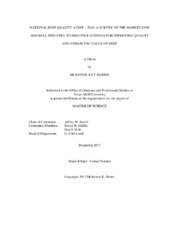| dc.description.abstract | The National Beef Quality Audit – 2016 marks the fourth iteration in a series assessing the quality of live beef and dairy cows and bulls and their carcass counterparts. Conducted from March through December of 2016, trailers (n = 154), live animals (n = 5470), hide-on carcasses (n = 5279), hide-off hot carcasses (n = 5510), chilled carcasses (n = 4285), and offal items (n = 4800) were surveyed in 18 commercial packing facilities throughout the United States. Cattle were hauled in all types of trailers for a mean distance of 455.7 km for 6.7 h and had a mean of 2.3 m² of space during transit. Of the mixed gender loads of cattle arriving at the packing facility, cows and bulls were not segregated on 64.4% of the trailers surveyed. When assessed for mobility, 81.3% of cattle surveyed were sound. The mean body condition score for beef animals was 4.7 and for dairy cows and bulls was 2.6 and 3.3, respectively. Since the previous National Market Cow and Bull Beef Quality Audit (2007), dairy cattle have trended to be lighter muscled, yet fatter. Of cattle surveyed, 12.0% had horns, and 63.2% had no visible live animal defects. Beef cattle were primarily black-hided, while dairy cattle were primarily Holstein-patterned. Just over half (56.0%) of the cattle had no mud contamination on the hide, and an additional 34.1% only had small amounts of mud on the hide. Native (unbranded) hides were observed on 77.3% of cattle. Carcass bruising was evident on 64.1% of cow carcasses and 42.9% of bull carcasses. However, over half of all cattle surveyed had bruises which were only minimal in severity. Nearly all cattle (98.4%) were free of visible injection site lesions. Harvest floor assessments indicated 44.6% of livers, 20.0% of viscera, 23.1% of lungs, 22.3% of hearts, 8.2% of heads, and 5.9% of tongues were condemned. Of the cows surveyed, 17.4% carried fetuses at time of harvest. Mean USDA quality grade attributes were skeletal maturity (D⁶⁴), lean maturity (C³⁸), overall maturity (D¹³), and marbling score (Slight⁶⁴). The highest frequency of each USDA quality grade for cows surveyed were USDA Utility. The mean USDA yield grade attributes were preliminary yield grade (2.5), carcass weight (311.5 kg), LM area (65.4 cm²), KPH (1.7%), and USDA yield grade (2.9) for all carcasses surveyed. The National Beef Quality Audit - 2016 is an important addition to the Quality Audit series. Comparisons across years allow for assessment of beef quality improvement. In addition, current results provide guidance for continued educational and research efforts for improving market cow and bull beef quality. | en |


